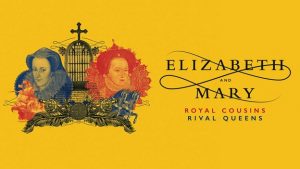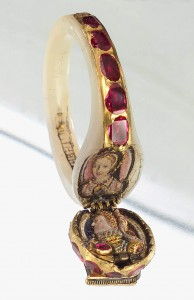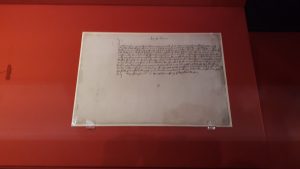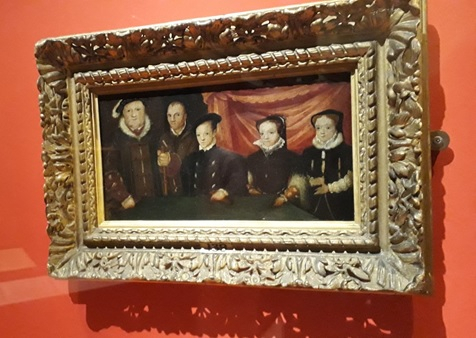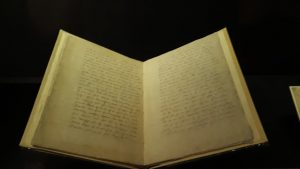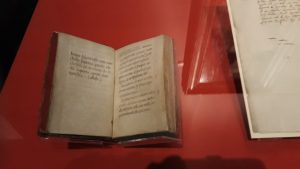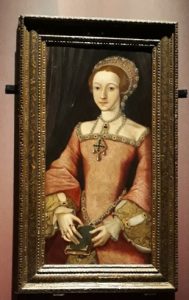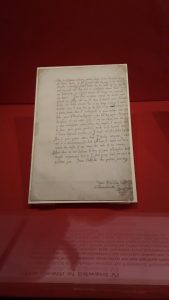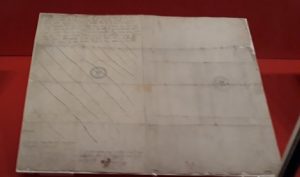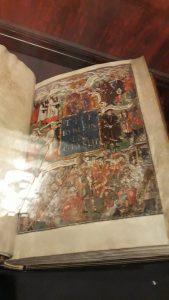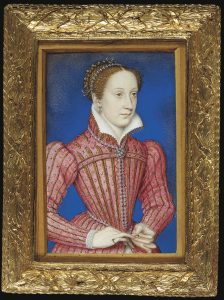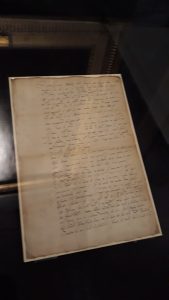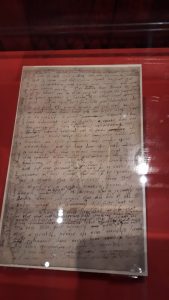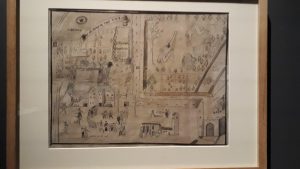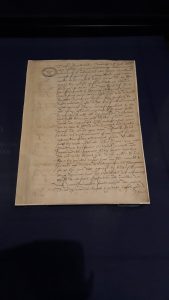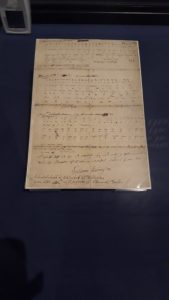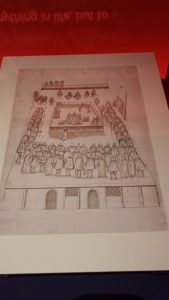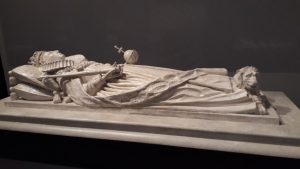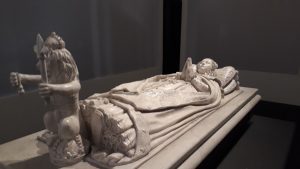‘Elizabeth and Mary: Royal Cousins, Rival Queens’ Exhibition opened at the British Library on 8th October 2021 and will close on 20 February 2022.
It is well worth a visit for Tudor fans. I think it was one of the best exhibitions I have been to!
‘This is the first exhibition to consider Elizabeth I and Mary, Queen of Scots together. Using their own words, it tells the story of two women who never met but were bound by their shared experience as sovereign queens and their rivalry for the English and Irish thrones.
Elizabeth and Mary’s complex relationship dominated English and Scottish politics for three decades. It is explored here in the context of the religious reformation that divided Europe between Catholics and Protestants.
The exhibition reveals how Elizabeth and Mary’s battle, first for dynastic pre-eminence, then for survival, became inseparable from national religious struggle.’
(c) British Library
My favourite items in the exhibition included:
Henry VIII’s Great Bible
Elizabeth I’s locket ring
Tide written by Princess Elizabeth to Mary I
Boughton Family portrait of Henry VIII
Portrait of Mary, Queen of Scots
Eyewitness drawing of execution of Mary, Queen of Scots
Jane and Katherine Grey also got a couple of mentions.
This was the third time that I had seen the locket ring owned by Elizabeth I and includes portraits of Elizabeth and her mother, Anne Boleyn. It is still amazing to see!
There was also the birth announcement of Princess Elizabeth sent from Queen Anne Boleyn to George Brooke, Lord Cobham from Greenwich Palace on 7 September 1553.
Ever since this portrait was discovered by Tracy Borman and Alison Weir at Boughton House in May 2008, I have wanted to see it!
Their research was published in an article in the June 2008 issue of the BBC History Magazine, suggesting that this new portrait of Elizabeth could be used to identify the portrait of an unknown woman owned by the National Portrait Gallery and previously thought to be Lady Jane Grey.
‘This rare Tudor family portrait is a later copy of a work that was probably painted during Edward VI’s reign. Edward occupies the centre of the composition, while his half-sisters, Mary and Elizabeth, stand off to the side. The figure between Henry VIII and Edward has been identified as the court fool Will Somer. The painting provides a glimpse of Elizabeth as a young woman who was about to endure some of the most difficult years of her life.’
‘In December 1546 a gravely ill Henry VIII drew up his will, which established a regency government for his son, Edward. It repeated existing provisions for the succession, that if Edward were to die without legitimate heirs, the crowns of England and Ireland would pass to Mary and Elizabeth. In 1544, Henry had restored both his daughters to the succession. The offspring of Henry’s younger sister, Mary Tudor, were placed next, before those of his elder sister, Margaret – thus overlooking Mary, Queen of Scots.’
‘Elizabeth translated her stepmother Katherine Parr’s Prayer’s and Meditations from English into Latin, Italian and French in her beautiful italic hand, as a gift for her father. The embroidered cover, with Henry VIII and Katherine’s initials, is also thought to be her handiwork. Katherine’s Protestant faith had a profound impact on Elizabeth’s own religion.’
This was the second time I had seen this portrait. I think it was part of the ‘Lost Faces – Identity and Discovery in Royal Tudor Portraiture’ which was held at the Philip Mould Historical Portraits Gallery in London from 6th-18th March 2007.
‘In early 1553 Elizabeth wrote to Edward, having been prevented from seeing him due to his failing health. She likened herself to ‘a shipman in story weather’ repulsed by ‘troublesome waves’ but trusted that Edward’s ‘goodwill will stick by me’. Four months later and nearing death, Edward attempted to alter the succession in favour of his cousin, the Protestant Lady Jane Grey. On 19 July his Catholic sister Mary became Queen nonetheless and Jane was beheaded.’
‘In March 1554, Elizabeth learned that she was to be sent to the Tower of London for suspected involvement in Wyatt’s Rebellion against Mary I. Elizabeth petitioned to see her sister, reminding Mary of her promise ‘that I be not condemned without answer and due proof’. Elizabeth scored through the space above her signature to prevent anyone from doctoring her letter. She wrote slowly knowing that once the tide on the Thames had turned, her journey by boat to the Tower and her imprisonment – would be delayed for an extra day. Mary refused Elizabeth an audience.’
‘Elizabeth inherited a daunting religious legacy. Henry VIII had broken with the Pope in 1533, Edward VI made the new Church of England Protestant, and Mary I restored Catholicism. In 1538 the reformer Miles Coverdale was commissioned to produce a new translation of the Latin Vulgate, which was intended to become the single authoritative Bible in English. More than 9000 copies of this new translation were printed between 1539 and 1541, one for every parish. This illuminated copy, later inherited by Elizabeth, was originally presented to Henry VIII.’
‘On 19 August 1561 Mary landed at Leith, with ‘her whole train not exceeding sixty persons of mean sort’, as reported here by the English Principal Secretary, Sir William Cecil. John Knox took a similarly jaundiced view, interpreting the weather as a divine warning: there ‘was never seen a more dolorous face of the heaven, than was at her arrival’. Cecil’s letter also included the news that Elizabeth’s cousin Lady Katherine Grey remained prisoner in the Tower for her clandestine marriage. Elizabeth regarded Katherine’s claim to the crown as a direct threat.’
‘ The debates on the succession in the 1566 parliament were divided between supporters of Mary, Queen of Scots and Katherine Grey. An angry Elizabeth tried to silence her MPs. Shown here is her own, heavily edited, draft of her closing speech, in which she attached those ‘lip-laboured orations out of such jangling subjects’ mouths’. When Elizabeth gave the speech, she omitted the word ‘jangling’ and forgave her MPS ‘their handling of this’ matter. Despite her admonition, future parliaments debated the succession.’
‘In summer 1586 Anthony Babington plotted a Catholic uprising, supported by Spain, to free Mary and crown her Queen. Walsingham knew of the plot from the outset. Mary’s correspondence with the conspirators was smuggled in and out of her prison hidden in beer barrels. But Walsingham’s double-agents intercepted it and Thomas Phelippes copied and deciphered each letter before sending it to the intended addressee. Realising this letter from Mary to Babington would condemn her for treason, Phelippes drew a gallows on his copy. Babington burned the original.’
‘Over 100 cipher systems were found among Mary’s papers, which she used to correspond secretly. Following his arrest, Babington confessed to his part in the plot and signed his confession here that this was the cipher Mary and he used to communicate. The cipher consists of 23 symbols representing letters of the alphabet and 35 symbols representing specific words or phrases. Babington was convicted of treason and hanged, drawn and quartered.’
‘Robert Beale, Clerk of the Privy Council, attended Mary’s execution at Fotheringhay on 8 February 1587. His eye-witness drawing depicts Mary three times: entering the hall, disrobing, and placing her head on the block. Shrewsbury (1), Kent (2), and Paulet (3) are shown seated. Beneath her black outer garment, Mary wore crimson, the colour of Catholic martyrdom. Her last words were, ‘into your hands, O’Lord’ and perhaps also her motto, ‘in my end is my beginning’. She was beheaded at the third stroke of the axe, aged 44.’
In the final room of the exhibition, were replicas of the effigies on the tombs of Elizabeth I and Mary, Queen of Scots at Westminster Abbey.

